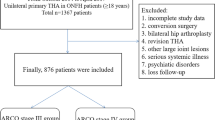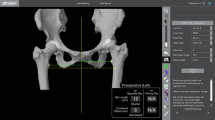Abstract
Robot-assisted total hip arthroplasty (R-THA) is increasingly being performed throughout the world. The invasiveness of this operation is unknown. We retrospectively reviewed the cohort of consecutive osteonecrosis of the femoral head (ONFH) patients who received primary R-THA or manual THA (M-THA) from January 2020 to January 2022 in our institution. One experienced surgeon performed all procedures. We calculated the propensity score to match similar patients in different groups by multivariate logistic regression analysis for each patient. We included confounders consisting of age, sex, body mass index (BMI), and operation time. Preoperative serum markers and Harris hip scores (HHS), postoperative serum markers at first day and third day, complications rate, postoperative HHS and Forgotten Joint Score (FJS) at 6 months after surgery of different cohorts were compared. We analyzed 218 ONFH patients treated with THA (98 R-THA patients, and 120 M-THA patients). After propensity score matching, we generated cohorts of 95 patients in R-THA and M-THA groups. We found no significant difference in preoperative serum markers and HHS. In the R-THA cohort, the PLT count was significantly lower on the postoperative day 1 (192.36 ± 41.72 × 109/L Vs 210.47 ± 72.85 × 109/L, p < 0.05). The Hb level was significantly lower on the postoperative third day in the R-THA cohort (98.52 ± 12.99 g/L Vs 104.74 ± 13.15 g/L, p < 0.05). There was no significant difference in the other serum markers between the cohorts on postoperative day 1 and 3 (p > 0.05). The FJS was significantly higher in the R-THA than M-THA group (p = 0.01). There was no significant difference in the postoperative HHS or complication rate between the groups (p > 0.05). The R-THA is not associated with a serious invasiveness compared to M-THA. Patients who underwent R-THA had a better early function compared to those who underwent M-THA.



Similar content being viewed by others
Availability of data and materials
All data generated or analyzed during this study are included in this published article.
References
Kayani B, Konan S, Thakrar RR et al (2019) Assuring the long-term total joint arthroplasty: a triad of variables. Bone Joint J 101-b:11–18. https://doi.org/10.1302/0301-620x.101b1.Bjj-2018-0377.R1
Hayashi S, Hashimoto S, Kuroda Y et al (2021) Robotic-arm assisted THA can achieve precise cup positioning in developmental dysplasia of the hip : a case control study. Bone Jt Res 10:629–638. https://doi.org/10.1302/2046-3758.1010.Bjr-2021-0095.R1
Chai W, Xu C, Guo RW et al (2022) Does robotic-assisted computer navigation improve acetabular cup positioning in total hip arthroplasty for Crowe III/IV hip dysplasia? A propensity score case-match analysis. Int Orthop 46:769–777. https://doi.org/10.1007/s00264-021-05232-w
Domb BG, El Bitar YF, Sadik AY et al (2014) Comparison of robotic-assisted and conventional acetabular cup placement in THA: a matched-pair controlled study. Clin Orthop Relat Res 472:329–336. https://doi.org/10.1007/s11999-013-3253-7
Singh V, Realyvasquez J, Simcox T et al (2021) Robotics versus navigation versus conventional total hip arthroplasty: does the use of technology yield superior outcomes? J Arthroplasty 36:2801–2807. https://doi.org/10.1016/j.arth.2021.02.074
Tsunoda K, Sonohata M, Kugisaki H et al (2017) The effect of air tourniquet on interleukin-6 levels in total knee arthroplasty. Open Orthop J 11:20–28. https://doi.org/10.2174/1874325001711010020
Kumbhare D, Parkinson W, Dunlop B (2008) Validity of serum creatine kinase as a measure of muscle injury produced by lumbar surgery. J Spinal Disord Tech 21:49–54. https://doi.org/10.1097/BSD.0b013e31805777fb
Kumbhare D, Parkinson W, Dunlop B et al (2007) Biochemical measurement of muscle injury created by lumbar surgery. Clin Invest Med 30:12–20. https://doi.org/10.25011/cim.v30i1.444
Tanavalee A, Honsawek S, Rojpornpradit T et al (2011) Inflammation related to synovectomy during total knee replacement in patients with primary osteoarthritis: a prospective, randomised study. J Bone Jt Surg Br 93:1065–1070. https://doi.org/10.1302/0301-620x.93b8.26719
Honsawek S, Deepaisarnsakul B, Tanavalee A et al (2011) Relationship of serum IL-6, C-reactive protein, erythrocyte sedimentation rate, and knee skin temperature after total knee arthroplasty: a prospective study. Int Orthop 35:31–35. https://doi.org/10.1007/s00264-010-0973-0
Kayani B, Tahmassebi J, Ayuob A et al (2021) A prospective randomized controlled trial comparing the systemic inflammatory response in conventional jig-based total knee arthroplasty versus robotic-arm assisted total knee arthroplasty. Bone Jt J 103-b:113–122. https://doi.org/10.1302/0301-620x.103b1.Bjj-2020-0602.R2
Bergin PF, Doppelt JD, Kephart CJ et al (2011) Comparison of minimally invasive direct anterior versus posterior total hip arthroplasty based on inflammation and muscle damage markers. J Bone Jt Surg Am 93:1392–1398. https://doi.org/10.2106/jbjs.J.00557
Fontalis A, Kayani B, Asokan A et al (2022) Inflammatory response in robotic-arm-assisted versus conventional jig-based TKA and the correlation with early functional outcomes: results of a prospective randomized controlled trial. J Bone Jt Surg Am 104:1905–1914. https://doi.org/10.2106/jbjs.22.00167
Baird MF, Graham SM, Baker JS et al (2012) Creatine-kinase- and exercise-related muscle damage implications for muscle performance and recovery. J Nutr Metab 2012:960363. https://doi.org/10.1155/2012/960363
Silverstein TP, Kirk SR, Meyer SC et al (2015) Myoglobin structure and function: a multiweek biochemistry laboratory project. Biochem Mol Biol Educ Bimon Publ Int Union Biochem Mol Biol 43:181–188. https://doi.org/10.1002/bmb.20845
Brancaccio P, Lippi G, Maffulli N (2010) Biochemical markers of muscular damage. Clin Chem Lab Med 48:757–767. https://doi.org/10.1515/cclm.2010.179
Germolec DR, Shipkowski KA, Frawley RP et al (2018) Markers of inflammation. Methods Mol Biol (Clifton, NJ) 1803:57–79. https://doi.org/10.1007/978-1-4939-8549-4_5
Galia CR, Diesel CV, Guimarães MR et al (2017) Total hip arthroplasty: a still evolving technique. Rev Bras Ortop 52:521–527. https://doi.org/10.1016/j.rboe.2016.09.011
Scott CEH, Clement ND, Davis ET et al (2022) Modern total hip arthroplasty: peak of perfection or room for improvement? Bone Jt J 104:189–192. https://doi.org/10.1302/0301-620x.104b2.Bjj-2022-0007
Oltean-Dan D, Apostu D, Tomoaia G et al (2022) Causes of revision after total hip arthroplasty in an orthopedics and traumatology regional center. Med Pharm Rep 95:179–184. https://doi.org/10.15386/mpr-2136
Ando W, Takao M, Hamada H et al (2021) Comparison of the accuracy of the cup position and orientation in total hip arthroplasty for osteoarthritis secondary to developmental dysplasia of the hip between the Mako robotic arm-assisted system and computed tomography-based navigation. Int Orthop 45:1719–1725. https://doi.org/10.1007/s00264-021-05015-3
Clement ND, Gaston P, Bell A et al (2021) Robotic arm-assisted versus manual total hip arthroplasty. Bone Jt Res 10:22–30. https://doi.org/10.1302/2046-3758.101.Bjr-2020-0161.R1
Shaw JH, Rahman TM, Wesemann LD et al (2022) Comparison of postoperative instability and acetabular cup positioning in robotic-assisted versus traditional total hip arthroplasty. J Arthroplasty 37:S881-s889. https://doi.org/10.1016/j.arth.2022.02.002
Zhang S, Liu Y, Yang M et al (2022) Robotic-assisted versus manual total hip arthroplasty in obese patients: a retrospective case-control study. J Orthop Surg Res 17:368. https://doi.org/10.1186/s13018-022-03263-6
Morrell AT, Layon DR, Scott MJ et al (2021) Enhanced recovery after primary total hip and knee arthroplasty: a systematic review. J Bone Jt Surg Am 103:1938–1947. https://doi.org/10.2106/jbjs.20.02169
Kamara E, Berliner ZP, Hepinstall MS et al (2017) Pin site complications associated with computer-assisted navigation in hip and knee arthroplasty. J Arthroplasty 32:2842–2846. https://doi.org/10.1016/j.arth.2017.03.073
Subramanian P, Wainwright TW, Bahadori S et al (2019) A review of the evolution of robotic-assisted total hip arthroplasty. Hip Int J Clin Exp Res Hip Pathol Ther 29:232–238. https://doi.org/10.1177/1120700019828286
Cohen RG, Katz JA, Skrepnik NV (2009) The relationship between skeletal muscle serum markers and primary THA: a pilot study. Clin Orthop Relat Res 467:1747–1752. https://doi.org/10.1007/s11999-009-0809-7
Morrell CN, Aggrey AA, Chapman LM et al (2014) Emerging roles for platelets as immune and inflammatory cells. Blood 123:2759–2767. https://doi.org/10.1182/blood-2013-11-462432
Musallam KM, Tamim HM, Richards T et al (2011) Preoperative anaemia and postoperative outcomes in non-cardiac surgery: a retrospective cohort study. Lancet (London, England) 378:1396–1407. https://doi.org/10.1016/s0140-6736(11)61381-0
Funding
Beijing Municipal Science and Technology Commission Foundation (Grant No. Z221100003522014).
Author information
Authors and Affiliations
Contributions
MM and ZC: wrote the main manuscript text. MY: performed data extraction and analysis. Oversight of the research, including the conception and design of the study, and manuscript preparation, was performed by XK and WC (co-corresponding authors). All authors read and approved the final manuscript.
Corresponding authors
Ethics declarations
Conflict of interest
The authors declare that they have no competing interests.
Ethics approval and consent to participate
The medical ethics committee of our institution approved the study “Clinical outcome study of robotic-assisted orthopedic surgery in total hip arthroplasty”. All procedures were conducted in compliance with the guidelines of the Declaration of Helsinki. The patients were informed consent prior to their participation in the study.
Consent for publication
We have obtained consent for publication.
Additional information
Publisher's Note
Springer Nature remains neutral with regard to jurisdictional claims in published maps and institutional affiliations.
Rights and permissions
Springer Nature or its licensor (e.g. a society or other partner) holds exclusive rights to this article under a publishing agreement with the author(s) or other rightsholder(s); author self-archiving of the accepted manuscript version of this article is solely governed by the terms of such publishing agreement and applicable law.
About this article
Cite this article
Ma, M., Cao, Z., Yang, M. et al. The invasiveness of robot-assisted total hip replacement is similar to that of conventional surgery. J Robotic Surg 17, 2987–2993 (2023). https://doi.org/10.1007/s11701-023-01740-6
Received:
Accepted:
Published:
Issue Date:
DOI: https://doi.org/10.1007/s11701-023-01740-6




